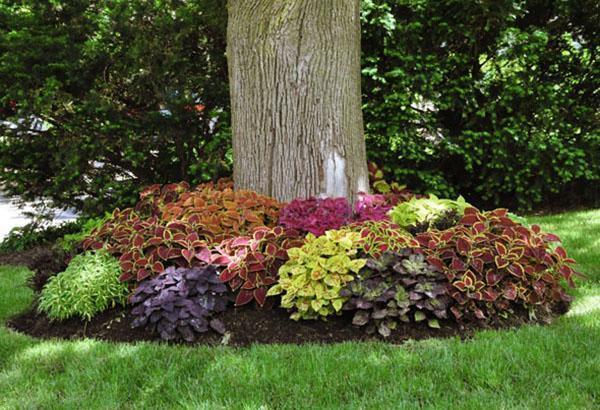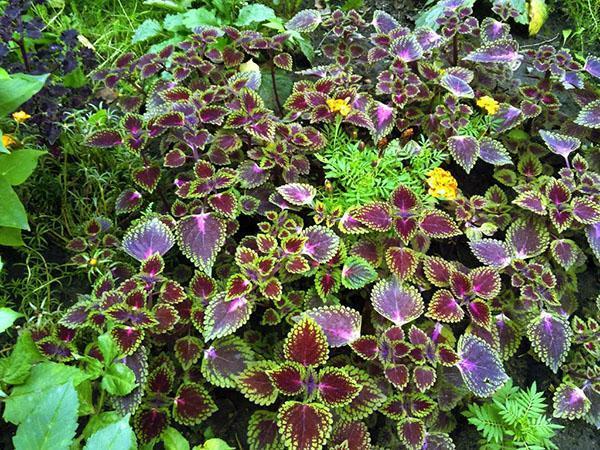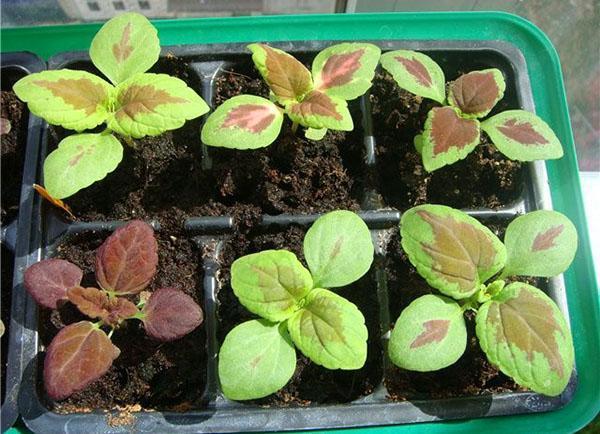Planting and caring for the Coleus at home in the open field
 The tropics gave the world coleus... Planting and caring for the plant outdoors is simple and the landscape is stunning. During the season, the plant manages to create a bush of beautiful velvet leaves iridescent with multicolored ornament. With the shape of a ribbed stem and jagged leaves, Coleus resembles a nettle and has received an affectionate popular nickname - “nettle”. Coleus is valued for decorative leaves of various color combinations, rapid growth and unpretentious care. In the fall, the evergreen coleus plant, will take care at home with gratitude, continuing to delight with bright foliage.
The tropics gave the world coleus... Planting and caring for the plant outdoors is simple and the landscape is stunning. During the season, the plant manages to create a bush of beautiful velvet leaves iridescent with multicolored ornament. With the shape of a ribbed stem and jagged leaves, Coleus resembles a nettle and has received an affectionate popular nickname - “nettle”. Coleus is valued for decorative leaves of various color combinations, rapid growth and unpretentious care. In the fall, the evergreen coleus plant, will take care at home with gratitude, continuing to delight with bright foliage.
Coleus agricultural technology
Coleus, a thermophilic plant. For him, the temperature is below 120 C is already destructive. There is not enough time for germination and development of the bush in favorable conditions. Therefore, in the middle lane, Coleus in the open field is grown by planting and leaving through seedlings. The seeds can be harvested by yourself, but they will not reproduce the color of the parent bush. It is better to use varietal material from specialized farms. Grown from seeds, coleus take root well in the open field.
Young plants grow foliage quickly and it is the grower's job to provide:
- illuminated place with shading and wind protection;
- watering regular and plentiful;
- fertilization weekly, in the spring with a predominance of nitrogen, later, ash extracts for bright leaf color;
- the bushes are sheared as they grow, giving the desired shape.
With proper care, the coleus in the garden will look like in the photo.
How to properly grow Coleus seedlings
Coleus can be propagated by seed and cuttings. If you get young plants from seeds, then the seedlings will get different colors of the leaves. To obtain identical bushes, propagation by cuttings is used.
Sowing with seeds is carried out in March or April, depending on the period of the onset of summer in the region. The seeds are very small, they are laid out on the surface of the substrate and lightly sprinkled with sand. The container is covered with glass, kept warm, constantly moistening the surface. The seedlings that appear after two weeks will be hindered in a cool, bright place so that they do not stretch out.
 The time when it is necessary to dive coleus into separate cups is determined by the state of young seedlings. If they stretch, interfering with each other, then it's time for a transplant. Therefore, it is important to decompose the seeds of the Coleus as rarely as possible in order to get a strong plant with developed roots at the school stage.
The time when it is necessary to dive coleus into separate cups is determined by the state of young seedlings. If they stretch, interfering with each other, then it's time for a transplant. Therefore, it is important to decompose the seeds of the Coleus as rarely as possible in order to get a strong plant with developed roots at the school stage.
Picking a wheel will not cause any difficulties. The seedlings have good survival rate, they grow quickly. After the stems have grown to 10 cm, they begin to pinch, forming a bush. If the summer is delayed, you can do another transfer of the plant into a larger glass.
To ensure planting in the open ground and caring for the Coleus from seedlings, you need to dig holes, fill them with fertile soil, water and cross the bushes, damaging the roots as little as possible. Cover new plants for several days for better survival. Water the plants with soft and warm water.
In order to highlight the beauty of the carved leaves and the bright color of the Coleus in the composition, you need to plant it against the background of monochrome plants. The drawstring created by them will be an excellent protection from the wind.
In the fall, dig up annual plants, bring them to heat for future cuttings.The bush winters well at home on the window, delighting with its bright leaves. But caring for Coleus is associated with pruning. Otherwise, the bush will simply stretch out and lose its decorative effect.
 From February to May, all cut off upper shoots give roots in water or in wet sand in ten days. Then they are seated in cups, provided with proper care and young bushes are obtained for spring gardening of balconies and garden plots.
From February to May, all cut off upper shoots give roots in water or in wet sand in ten days. Then they are seated in cups, provided with proper care and young bushes are obtained for spring gardening of balconies and garden plots.
Cuttings seedlings completely repeat the coloring of the mother bush.
Caring for Coleus at home
 At home, the plant does not need much attention. The plant should be planted in a deep, spacious pot. Fertile soil and good drainage will create conditions for the development of the root system. The plant is waterlogged, but the leaves will fly around from stagnant water, and the root will rot.
At home, the plant does not need much attention. The plant should be planted in a deep, spacious pot. Fertile soil and good drainage will create conditions for the development of the root system. The plant is waterlogged, but the leaves will fly around from stagnant water, and the root will rot.
Bright window, but no direct sunlight. Summer spraying on the leaves with warm soft water is mandatory in caring for Coleus, as factors of proper agricultural technology. The flower loves fresh air and in the summer will decorate a balcony or veranda with a bright spot.
The peak of the decorativeness of Coleus falls at the age of 5 months from sowing a seed. Small-leaved varieties grow faster and cover the soil better. The higher the air temperature, the more often the plants are watered.
Water for irrigation from the water supply system should not only be settled, but also boiled so that there are no salts and chlorine compounds left. In summer, for a bright color, the plant needs trace elements in top dressing and nitrogen for rapid growth at the very beginning of development. In winter, watering is reduced, but the land is not dried. It is enough to carry out top dressing once a month. It is best to cut short-growing branches to give the bush a decorative effect in early spring. The plant will rejuvenate, there will be material for grafting. Proper care of the Coleus at home will create a bush worthy of a magazine cover photo.
Plant diseases and pests
 Coleus in care is considered an unpretentious plant, but some rules must be followed. From improper care, the plant can be weakened, lose its decorative appearance, and pests will settle on it. Indoor plants are more often affected.
Coleus in care is considered an unpretentious plant, but some rules must be followed. From improper care, the plant can be weakened, lose its decorative appearance, and pests will settle on it. Indoor plants are more often affected.
The main and common reasons can be:
- the stem has rotted below, this can happen with stagnant moisture, sour soil;
- the leaves begin to dry out from the tips - insufficient watering, dry air in the room, the plant is not sprayed regularly;
- the leaves on the nettle began to fall off - drafts and cold to the plant;
- spots on the leaves - sunburn;
- the leaves fade - there is not enough light or have not been fed for a long time;
- flower growth has slowed down - there is not enough nutrition in the soil.
All this will lead in the future to the colonization of the weakened bush by pests. They will manifest their presence by deformation, discoloration and drying of the leaves.